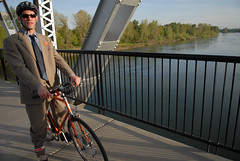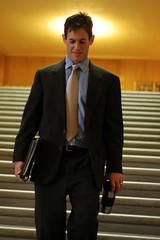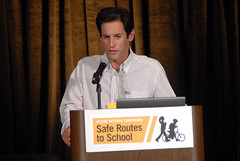[This story was co-written by Elly Blue and Jonathan Maus]

(Photos © J. Maus)
Last week the Board of Directors of the Bicycle Transportation Alliance (BTA) — Oregon’s largest bicycle advocacy organization — fired Scott Bricker after he served just two years as the organization’s executive director.
“What’s going on down there?” we were asked by David Hiller, advocacy director of the Cascade Bicycle Club, the BTA’s Washington State counterpart. “The whole national advocacy community is all atwitter about this and there aren’t any answers.”
Hiller’s sentiments were echoed here in the BTA’s own backyard, where many seemed to be caught off guard by the decision, which was effective immediately.
“Portland is at the forefront of bicycling, but we’ve stalled.”
— Mary Roberts, BTA Board Chair
But for those close to the BTA, Bricker’s departure was just the latest episode in a period of transition that has been underway at the organization for some time.
When Bricker took the reins of executive director in October of 2007 — a position he had referred to as his “dream job” just a few months prior — he had been with the BTA since 1998. But being the leader of a large and mature non-profit was something new to Bricker. “The learning curve was steep,” he told us in a recent interview.
Making that curve steeper, was the pressure (by himself and his Board) to right a ship that has been slowly drifting off course for years. Bricker replaced a former executive director, Evan Manvel, who left the organization after a similarly short tenure (two years) marked by mixed accomplishments.
Bricker immediately set his sights on sweeping changes. At the time of his hire, BikePortland interviewed Bricker and reported that he wanted to bring about an “evolution” at the BTA. “I’m looking to re-structure the entire organization,” he told us.
This he achieved, but not without casualties — including his own job. Bricker was the eighth staff member to be let go by the BTA in the 2009 calendar year. Job descriptions and reporting changed for most remaining employees, and new hires came with a new organizational structure. Furthermore, the news of his departure came in the wake of revelations that the organization was pulling itself out of a hole caused by inadequate accounting and financial oversight in 2008.
But greater than any structural difficulties, and with roots that go beyond Bricker’s tenure, has been a growing sense that the organization has lost touch with its vision and its membership, and that it has not kept pace with Portland’s bicycling boom. Moreover, complaints have grown that the BTA has been absent from advocacy outside of Portland.
Board Chair Mary Roberts, in an interview after Bricker’s departure, said that it has been about a year since she first began to get a sense that the BTA had lost its way. “Portland is at the forefront of bicycling,” she said, “but we’ve stalled.”
Roberts cited September’s event with David Byrne, widely criticized for its self-congratulatory tone, as a moment of clarity. “I literally sat there and thought to myself, I am embarrassed,” she said. “If that’s where we’re focused, that’s a problem. It was so in my face at that moment.”
“It’s begun to dawn on me that we’ve begun to become complacent, and that we are satisfied with very little funding, and that if we’re serious about bicycling being a serious mode of transportation we can’t just make a gesture….in order to make this real we can’t just settle for crumbs. There’s no one at fault here in this, it’s just something that we get used to.”
Others close to the BTA have also spoken of a growing sense of lost direction. This sense has in part been influenced by changes in the makeup of the Board of Directors in the last two years that brought in fresh perspectives and a wealth of business experience. The results have been eye-opening, said Roberts. Board member and former Nike executive Stephen Gomez initiated a “rebranding” process earlier this year, which has led to a closer look at the BTA’s communications efforts — and, in the bigger picture, its vision.
“Definitely, that vision piece went into the ED decision,” said Roberts, adding that “It’s been a process, a growing realization that we need to reorient the organization and move into the next era, and that definitely led into the ED decision.”
Bricker may not be the one Roberts and her Board colleagues want at the helm of the BTA in the new era to come, but his contributions to the organization over the past decade have been immense.
BTA board member Doug Parrow, who worked closely with Bricker for many years on the BTA’s legislative efforts, said, “Scott’s real strength, I think, was his ability to work within that state legislative structure.” Parrow indicated that the BTA’s legislative approach and goals will be shaped for many years to come by Bricker’s legacy.
Another of Bricker’s strong points has been program work, particularly youth education. He began at the BTA with the former iteration of their Safe Routes to School program, and brought the Safe Routes national conference to Portland this year. Under his tenure, the program flourished, and youth education became solidified as a pillar of the BTA, making up about a third of the organization’s staff and budget.
Safe Routes to School and the halls of the capitol were in Bricker’s comfort zone; but as the leader of a 5,000 member non-profit with 15 full-time staff and an annual budget well over $1 million, he was expected to excel on many other fronts as well.
A seasoned back-room negotiator as a lobbyist, Bricker brought that style with him as executive director. This proved effective in some cases, but in others it resulted in a confused and unsupportive public. Under his leadership, the BTA sometimes struggled to present clear positions on high-profile issues.
Last November we learned that the BTA supported a statewide point-of-sale bicycle excise tax as a way to raise money for bicycle infrastructure and their Safe Routes to Schools program. The BTA explained their support of a bike tax as being a “political reality,” but many in the community felt it was the wrong conversation to be having.
Several months later, Karl Rohde, the BTA’s Government Relations and Public Affairs Director, was abruptly fired right in the midst of the busy legislative session (Bricker hired Rohde less than two weeks after being named interim executive director). Rohde was hired to “raise the political savvy” of the BTA and his addition was a key part of Bricker’s re-structuring effort.
The reason for Rohde’s firing was never made public, but his absence must have had an impact on a disappointing legislative session which saw no significant gains for bicycle transportation. Rohde’s main legislative effort revolved around the Idaho Stop Law, which failed just 2 1/2 weeks after his departure.
The Columbia River Crossing project was perhaps Bricker’s most challenging policy issue. In an interview about it in May 2008, Bricker told us:
“Moreso than any other project I can think of, this project has had the most divergent set of opinions within the BTA in a long time… We are still having a hard time stating our positions.”
The BTA’s initial support of the CRC project drew scorn from some of their most active members. Even after issuing a position statement on the project in June 2008, the BTA continued to hear criticisms from members and the community. Attempting to answer those concerns, Bricker wrote a blog post to clarify their stance and even strengthened their tone against the project a few weeks later.
However, after Portland Mayor Sam Adams supported a 12-lane bridge option, the BTA again stopped short of criticizing the Mayor. When asked directly where they stood on the project, Bricker maintained his poker face, saying “12 lanes is just a number.”
One month later the BTA got tougher on the CRC, and finally — after nearly all the wheels had fallen off the controversial and increasingly unpopular project — they walked away from it altogether back in August.
As these messy policy debates played out in public, Bricker also struggled, he said in our discussion in August, to overcome his lack of management experience. It took him a year to begin to make the staffing changes he had immediately seen the need for, he said, in part because of reluctance to break up a longstanding team.
He helped to bring more business people onto the board; and this new board in turn, according to Roberts, demanded that the BTA increase its professionalism and financial transparency. This demand appears to have set off some of the tumultuous staffing changes of the past year.
Mia Birk, principal of Alta Planning and Design and long time insider on the local bike scene, said of Bricker’s departure:
“It’s ironic because he cleaned house, he brought in a new board, and I think it’s a compliment to Scott on a lot of levels that he took them to this place… He has something in him where he is humble enough to pick his own bosses that were more forceful than him. And the price he pays is that they turn around and say: ‘We need someone that can go toe-to-toe with us. You’re too sweet, we like you, but you don’t have the kind of leadership strengths we’re looking for.'”
Instead of hiring an interim director, the board chose to ask the BTA’s remaining directors to work with them to keep the organization running until a new ED can be hired. Angela Koch, who had been Bricker’s second-in-command as operations and communication director, said that the team is “…maintaining daily operations and making sure we’re still present in all of the initiatives we have going on. But in terms of any sort of broad shift — there’s not going to be any major change while we don’t have an ED.”
The board aims to hire a new director by March, 2010, Roberts said.
The BTA’s search for leadership and an identity comes at a pivotal time in Portland’s bike history: A monumental bicycle plan is on the home stretch to adoption and bicycling has support on all levels of government. In the meantime, the community is growing impatient with the status quo and has high expectations for its largest advocacy group.
For the BTA, the challenges ahead are numerous. To succeed, it will take more bold moves and the right balance of partnership and pressure needed to galvanize a community movement that’s just waiting to coalesce around a strong and focused leader.
Bricker has not yet responded to a call for comment.





